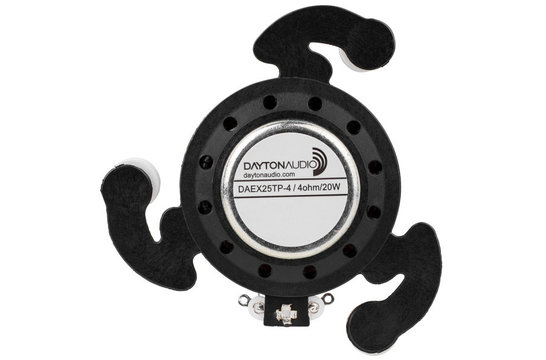





- We ship to United States of America
- Back in stock soon
- Five-year warranty
- 45-day cooling-off period to return
-
Customer rating:


















For turning larger surfaces into speakers, and more bass output, Dayton Audio's DAEX25TP-4 features three extended arms. Cooling vents draw air across the propietary voice coil for higher power handling.
Dayton Audio DAEX25TP-4 Tripod 25mm Exciter 20W 4 Ohm
Dayton Audio's DAEX25TP-4 tripod exciter is built with three arms that extend out from the main exciter body, which allows this exciter to transfer sound to a much larger surface for lower frequency response extension (more bass).
A neodymium magnet is employed to create maximum magnetic flux around the proprietary voice coil for increased sensitivity when compared to similar sized exciters. In turn, this reduces power requirements and makes it possible to use very small audio amplifiers, without sacrificing total output. The 2.54cm voice coil, and cooling vents, allows for more input power for higher output applications while maintaining a slim-line form factor.
To ensure maximum acoustic energy transfer between the transducer and the surface to which it is attached, 3M VHB (Very High Bond) adhesive is pre-applied to the main body, and the three arms ... just peel and stick! Two PCB solder points keep installation and wiring as compact as possible.
A great field of application for this exciter is so-called DML or flat-panel speakers. DML stands for Distributed Mode Loudspeakers and is a term for speakers that catch the eye with their incredibly slim design.
Curious about how to create invisible sound with exciters? In this blog, Ben Zenker, an expert with more than 15 years of experience and 10 internationally reviewed publications, shares his in-depth knowledge on material selection, installation and optimising sound quality. An indispensable resource for the passionate DIY audio enthusiast.
Note: An exciter's frequency response and sensitivity are completely dependent on the exciter's designated surface. Thinner, smaller materials will tend to be louder and create a mid/tweeter response. Thicker, larger materials (with multiple exciters) will be slightly quieter but result in a more full-range sound.
To learn more about Dayton Audio Exciters, and for help on which Exciter is right for you, check out Understanding & Using Dayton Audio Exciters.
Show more